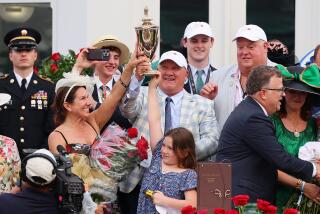Star horse’s new finish line
Archaeologist Lynn Swartz Dodd has excavated ancient sites in Egypt and Turkey. Her colleague Tom Garrison runs a dig site of Maya ruins in Guatemala.
On Saturday they descended into a trench outside the former Hollywood Park racetrack in Inglewood to explore some more recent history.
They were looking for the remains of a legendary racehorse.
Native Diver was a wild-eyed black colt so fast and so beloved that when he died in 1967, he was buried at his hometown track. An elaborate stone memorial marks the grave, a testament to a bygone era when horses and their owners were national celebrities, and when tens of thousands of fans packed the stands of Hollywood Park to cheer on their favorite steed.
The track closed in December after years of declining revenue. Its owners plan to tear it down and build an office and shopping complex. Richard Shapiro, the grandson of the man who bred and owned Native Diver, said he couldn’t bear the thought of buildings atop the horse’s grave.
“He’s racing royalty,” said Shapiro, 60, who asked USC for help with the excavation. “You couldn’t leave a horse like this beneath a real estate development.”
Once exhumed, Native Diver’s remains will be taken to Del Mar racetrack and stored there until a new burial site is prepared.
Before the dig started on Saturday, Shapiro gave a short presentation about Native Diver to Dodd and Garrison, who are both professors at USC, and about a dozen archaeology students who had come to help.
The first horse bred in California to earn more than a million dollars, Native Diver won 34 stakes races and still holds the record, with another horse, for most Hollywood Gold Cup wins.
Shapiro showed off a photograph taken as Native Diver crossed the finish line in his 1961 Gold Cup win. On the back, actor Cary Grant, who served on Hollywood Park’s board of directors, wrote: “Congratulations Richard!”
The track was opened in 1938 by a group of shareholders that included Al Jolson, Bing Crosby and Walt Disney and was long a favorite destination for Hollywood celebrities.
Shapiro, a real estate developer who served on the California Horse Racing Board from 2004 to 2008, grew up at the track. He remembers sitting in a box with his grandparents, who paid the young boy a dime for every race he correctly called. His grandfather, Louis, ran a women’s coat company and bred horses as a hobby on the family’s rambling ranch in Canoga Park.
They raised many horses, but only one Native Diver.
“He was jet-black and he was very fiery and he knew he was a star,” Shapiro said. When trotted out in the post parade after a successful race, the horse would stop, throw his head back and look proudly into the stands, Shapiro said. He quickly became a fan favorite.
Native Diver died of colic at the age of 8. His death made headlines around the country. At home in Canoga Park, the Shapiros were bereft. “It was like a death in the family,” he said.
Standing on the side of the dig site after six hours of excavation, Shapiro said he felt unexpectedly emotional. The skeleton of the horse was slowly emerging from the earth.
Garrison, holding a trowel, pointed at one of the front legs, which appeared to be striding. “He actually looks like he’s running,” Garrison said.
Shapiro nodded: “He never stopped.”
--
More to Read
Go beyond the scoreboard
Get the latest on L.A.'s teams in the daily Sports Report newsletter.
You may occasionally receive promotional content from the Los Angeles Times.











